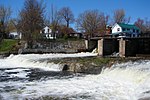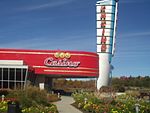USS Verdi

USS Verdi (SP-979) was a United States Navy patrol vessel in commission from 1917 to 1918. Verdi was built as a private motorboat of the same name in 1909 by the Charles L. Seabury Company and the Gas Engine and Power Company at Morris Heights in the Bronx, New York. She was the property of Walter J. Green of Utica, New York, and home-ported at Clayton, New York, on the St. Lawrence River when the U.S. Navy acquired her from Green on 30 June 1917 for use as a section patrol boat during World War I. She was commissioned as USS Verdi (SP-979) on 10 August 1917. Assigned to the 9th Naval District, Verdi patrolled on the Great Lakes for the rest of World War I. Verdi was returned to Green on 4 December 1918. She remained in civilian use until 31 July 1935, when she became stranded in the St. Lawrence River about 500 feet (150 meters) off Watch Island, New York, and became a total loss.
Excerpt from the Wikipedia article USS Verdi (License: CC BY-SA 3.0, Authors, Images).USS Verdi
Head Island Road,
Geographical coordinates (GPS) Address Nearby Places Show on map
Geographical coordinates (GPS)
| Latitude | Longitude |
|---|---|
| N 44.2495 ° | E -76.1547 ° |
Address
Head Island Road 40251
13624
New York, United States
Open on Google Maps



